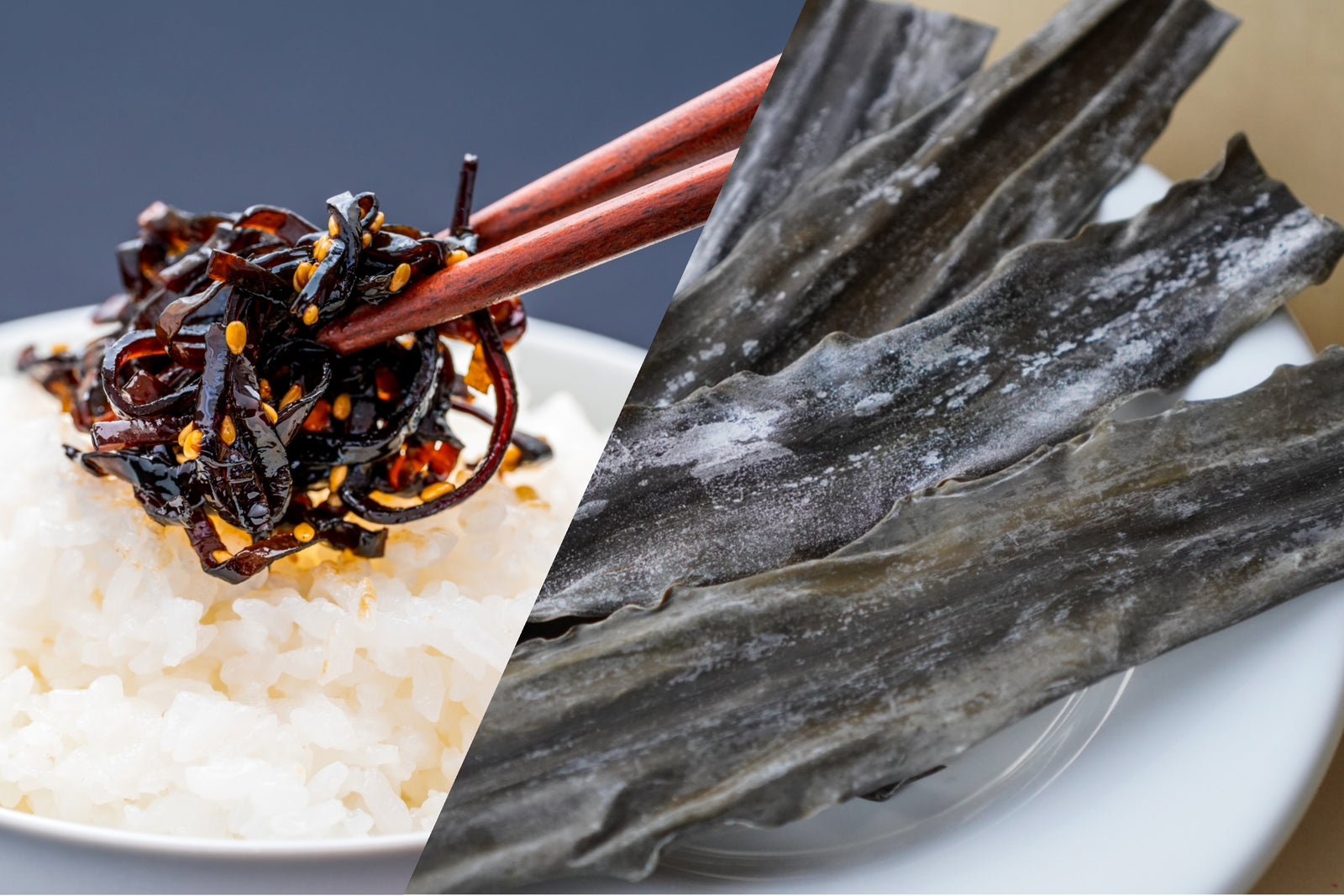これは何だか分かりますか?

これは昆布と呼ばれ、日本の食生活において非常に重要な食材です。
昆布って何ですか?
昆布(コンブ)は、コンブ目(Laminariales)褐藻類(Phaeophyceae)に属する大型藻類です。沿岸近くの冷たく比較的浅い水域に生息します。世界には35属が存在し、気候、海流、環境に応じて分布しています。14属の昆布は北海道、青森、岩手などの日本北部で栽培されており、そのうち90%以上は北海道産です。

北海道利尻島の利尻昆布
日本の歴史における昆布
昆布は3000年以上前から食用とされてきたと考えられています。最古の文献は、797年に編纂された続日本記(続日本記)に記されており、蝦夷地(北海道)の首長が朝廷に昆布を献上したことが記されています。朝廷は昆布を祝賀行事や宗教儀式に用いました。また、寺院にも献上され、精進料理にも使用されました。江戸時代(1603~1867年)には、昆布は全国的に広く利用されていました。
昆布は、幸せを象徴するものとして、お祝いの席で食べられます。これは、「昆布」という音が日本語で「喜ぶ」という「よろこぶ」に似ているためです。

手前のケースの中に、黄褐色の縞模様の茶色いものが2つ見えますか?これは昆布巻き、または昆布巻きと呼ばれ、魚卵を昆布で包んだものです。この箱は「おせち料理」と呼ばれ、お正月に食べる料理です。
栄養
昆布は先史時代の人々の食生活、特にナトリウム摂取において非常に重要な食材であったと考えられています。昆布はカルシウム、鉄、マグネシウム、カリウム、ヨウ素などのミネラルに加え、銅や亜鉛といった微量ミネラルも豊富に含んでいます。また、昆布はビタミン類も豊富に含み、食物繊維も豊富です。昆布は最もアルカリ性の強い食品の一つであり、体内のアルカリ性バランスを整え、健康に良いとされています。
昆布の秘密の味
昆布は料理に豊かな風味を加えます。それは、昆布がうま味を生み出すからです。うま味は、心地よい「だし」や「肉」のような味わいで、長く残るような食感があり、「心地よい風味」、あるいは甘味、塩味、酸味、苦味という4つの標準的な味覚とは異なる「第五の味」とも訳されます。うま味はグルタミン酸の相互作用によって生じます。昆布は、アミノ酸の一種であるグルタミン酸とアスパラギン酸を豊富に含んでいます。
昆布はうま味だけでなく、甘みも与えてくれます。白い粉がついているのが見えますでしょうか?

カビだと思うかもしれませんが、実はマンニトールという糖アルコールの一種で、乾燥すると自然に表面に浮き出てきます。これが昆布の甘みの元なのです。
日本の伝統料理における昆布の使い方
昆布は、生、乾燥、漬物など、様々な形で販売されています。細かく刻まれたもの、粉末にされたもの、細切りにされたものなど、様々な種類があります。乾燥昆布から作られる昆布だしは、日本の伝統料理における主要なだしの一つです。

昆布だし
昆布を日本酒、醤油、みりんなどで煮込んだ佃煮は、ご飯にのせる人気のトッピングです。

佃煮
生昆布、乾燥昆布、漬け昆布を使って、野菜炒め、漬物、サラダなどを作ることができます。昆布を使えば何でも作れます。昆布茶もありますよ!昆布茶は、乾燥させて細かく刻んだ昆布をお湯に浸けた、人気の健康飲料です。お店には昆布を使った加工品がたくさんあります。
コンビニでよく見かける昆布製品
コンビニ(日本のコンビニエンスストア)で昆布製品が売られているかどうか興味があります。コンビニは、ほとんどすべての街の通りの角にある、ワンストップショップ/新聞販売店の一種です。
近くのお店に行って、昆布製品がどれくらいあるか見てみました。そして、これを見つけました。

だし汁1本
佃煮2個(上記参照)
3おにぎり、おにぎりの中に佃煮が詰められています
4塩昆布塩で味付けした佃煮の一種
5昆布梅(日本のアプリコット)は、昆布を梅と塩で味付けしたスナックの一種です。
小さなお店でも、昆布を使った食品はたくさんあります。おにぎりをランチに、おやつを買って休憩に、あるいは家に持ち帰って料理に使うなど、昆布は生活のあらゆる場面で愛されています。昆布は昔も今も、日本の食生活に欠かせない食材です。

採れたての昆布
現在、日本以外の世界でも、環境保全の観点から、そして未来の食として、昆布が話題になっています。あなたも、昆布を生活に取り入れてみませんか?
昆布を使ったレシピ

今日のおすすめ

北海道利尻島の沿岸で収穫された乾燥昆布は、透明で風味豊かなだし汁を作ることができます。
風味豊かで塩味のあるこのお茶をお茶として飲みます。また、粉末を料理に加えてスープを作ることもできます。
このだし粉は、日高昆布(北海道日高産)、天然食塩、米砂糖、酵母エキスから作られ、天然香料を使用して日本のビーガン向けに販売されています。
当店では、その他にも昆布商品を多数取り揃えておりますので、ぜひご覧ください。


